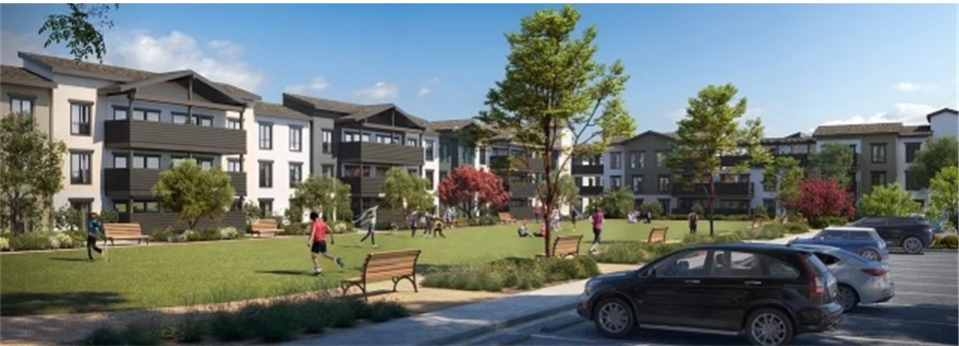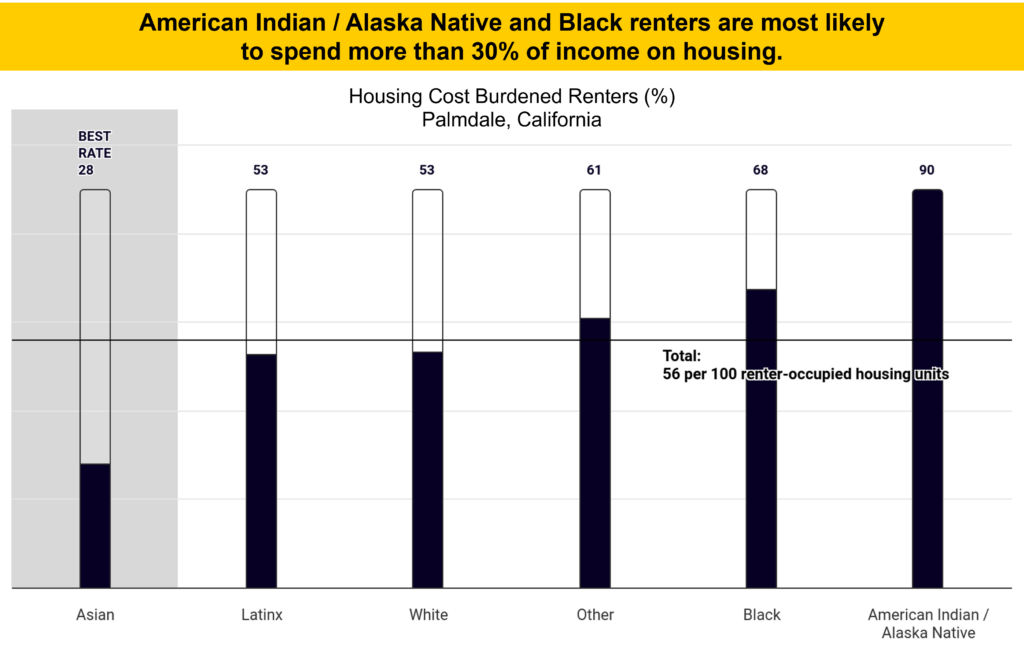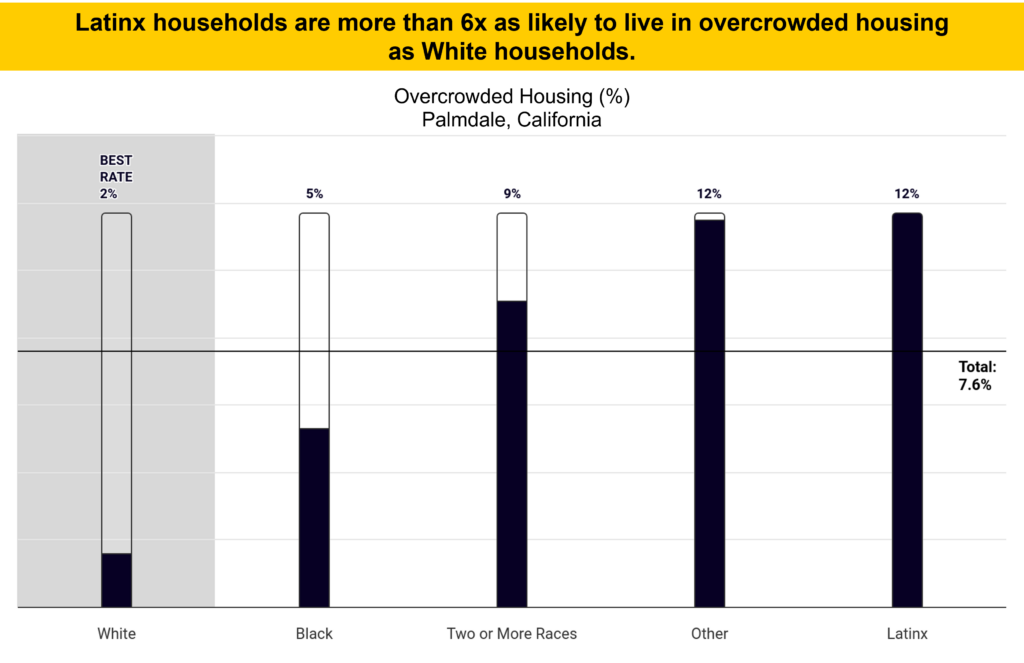
Source: Antelope Valley Times
By: Alexandra Baker
Research & Data Analyst I, Catalyst California
Paying rent in Los Angeles County is an enormous task when only 67% of county residents earn a living wage. The pressure to afford living in greater Los Angeles causes many to relocate outside of Los Angeles (city) to more affordable neighboring cities like Palmdale and Lancaster in the Antelope Valley.
Life in Palmdale promises affordable housing for families, a slower pace of life, and stunning desert views. The problem is: Palmdale itself is no longer affordable. As the housing crisis continues, Angelenos have moved further and further outside of city centers only to find that housing in those areas is now unaffordable. In fact, 56% of renters in both Palmdale and Los Angeles (city) are rent-burdened. The strategy of moving away from city centers to find affordable housing no longer works. Families in Palmdale are rent-burdened, and it has sweeping implications for the rest of the state.
“Historically, [the Antelope Valley] has been more affordable than other places in LA County… In the last 10 years, that has completely changed.”
Antelope Valley service provider
The Low Wage, High Rent Trap
Rent burden, by our definition, refers to spending 30% or more of income on rent. When people spend so much on rent, it means that they have less money for other necessities like childcare, transportation, food, and medical expenses. It also means families struggle to build savings and wealth. In Palmdale, more than half of renter-households are rent-burdened. American Indian / Alaska Native and Black renters are the most likely to be rent-burdened, with 90% and 67.5% of renter households respectively spending too much on rent.

These trends are partially the result of many Palmdale families not earning a livable wage. In the Antelope Valley, half of all households earn wages below the real cost of living which is adjusted for local costs.1 Even more worryingly, 83% of families with children under the age of six earn incomes below the real cost of living. The vast majority of families with young children must make tough choices during their children’s most critical education years.
Community members acknowledge the sting of high rents in combination with stagnating wages. In an interview we conducted for the State of the Child Antelope Valley Report, one resident service provider said: “Historically, [the Antelope Valley] has been more affordable than other places in LA County… In the last 10 years, that has completely changed. Our housing is no longer affordable, especially for those on any type of services… It doesn’t surprise me that half of the households can’t afford the cost of living.”2
How Did We Get Here?
The combination of extremely high housing costs, housing shortages, and stagnating wages have hurt residents’ ability to afford housing. This applies to people of color in particular, who are more likely to be renters in part because the government historically excluded them from the GI Bill and Federal Housing Authority lending.3
In Los Angeles County, housing construction has not kept up with demand for affordable housing. As a result, home prices rose 291% between 2002 to 2022.4 During the same period, fair market rents increased by 254%.5 Unfortunately, wages have grown more slowly than housing costs, only rising 170%.6 As a result, LA County residents do not have nearly as much purchasing power to buy or rent a home. While both renting and buying a home are increasingly unaffordable options, renting is the more viable option for many due to lack of a down payment and inequitable access to lending services among other causes.7
The affordable housing shortage8 means higher housing costs. Rising rents statewide impact smaller localities like Palmdale in two ways: its own costs rising with overall trends while also accommodating renters who are trying to escape the housing markets of Los Angeles and other more expensive cities. As of 2023, the average rental in Los Angeles (city) jumped up to about $2,7199 per month compared to Palmdale with an average of $1,884 month.10 Despite rent being lower in Palmdale, it is still $182 more than the national average.11
New units are not being built fast enough to accommodate the demand for housing because of California’s slow growth policies12 and permitting processes that make it expensive and slow to build new housing. There is also active opposition from predominantly single-family home areas with Not in My Backyard (NIMBY) campaigns13 by residents against higher-density housing that slows down and can even stop construction.
At the same time, California has only inconsistent rent stabilization efforts. Historically there has been little in the way of tenant protections in LA County,14 made worse with laws that actively work against renters’ need for low-cost housing with the passing of the Ellis Act (1985) and Costa Hawkins Rental Housing Act (1995). There is a patchwork of rent control policies at various levels, including the Tenant Protection Act (2019), the only recent statewide tenant protection that caps rent, and the LA County Rent Stabilization and Tenant Protections Ordinance. The only local rent control protections in the City of Palmdale apply to mobile homes meaning that many renters in Palmdale do not have access to rent control.15 Without strong tenant protections and rights like rent control, predatory landlords can take advantage of vulnerable tenants by raising their rents rapidly.
Palmdale Renters Are More Vulnerable Now
Palmdale renters have had to make cutbacks on necessities such as health care, food, childcare, savings, and transportation. To reduce the rent burden, renters may share housing which can result in overcrowding and opting for overcrowded housing. Palmdale’s Latinx families are most impacted by overcrowding, they are six times more likely to live in overcrowded housing than White families.

This higher level of overcrowding in Latinx households may contribute to the relatively lower percentage of Latinx rent-burden. Housing unaffordability can also lead to housing instability. Palmdale, like other places in California, has seen an increase in evictions and housing insecurity. Eviction Lab counted 636 evictions between 2013 and 2017 in the Antelope Valley.16 That number was projected to increase as pandemic-related eviction moratoriums expire.
Other markers of housing instability include homelessness. In and around Palmdale and Lancaster, 3,570 unsheltered and 1,028 sheltered people experienced homelessness in 2022.17 Overall, cutting back on necessities, overcrowded housing, poor quality housing, and housing instability can all have a negative impact on health and well-being.
What Can We Do?
Immediate action is required to mitigate the housing crisis in Palmdale. There has been some progress with Governor Gavin Newsom signing legislation including SB423 that continues fast-tracking approvals for apartments, condos, and townhouses that include affordable units; SB567 that makes it harder for landlords to illegally evict tenants; AB12 that lowers security deposit requirement; and AB1482 that caps rent increases at 5% plus inflation. There have also been more exploratory approaches to affordable housing like SB555 that requires the state’s Department of Housing and Community Development to create a California Social Housing Plan.
At the local level, the City of Palmdale plans to increase the number of available units. The Palmdale City Council approved its updated General Plan Housing Element in January 2022, which calls for 6,640 new housing units within the next eight years.18 It includes 1,777 very-low-income units and 935 low-income units, a much-needed step to address the demand for affordable housing.19 In addition, Palmdale also allows residents to build one or two accessory dwelling units on single-family home properties.20
Still, more is needed to address the housing crisis. In the State of the Child Antelope Valley report, we asked Palmdale residents what they would like to see policymakers do. One interviewee responded, “Cut the red tape, we have empty buildings that belong to the city, and a lot of city land, why do we keep giving breaks to big corporations to build[?] City Officials campaign a lot on unhoused and foster youth, but nothing gets done.” This points to a solution particularly for areas like Palmdale with a substantial amount of undeveloped land: land banks and public authorities or nonprofits who redevelop unused properties into public affordable housing.
“Cut the red tape, we have empty buildings that belong to the city, and a lot of city land, why do we keep giving breaks to big corporations to build[?] City Officials campaign a lot on unhoused and foster youth, but nothing gets done.”
Palmdale resident
A combination of policies that tackle the housing crisis by addressing the housing supply and the wage stagnation issues is needed. Housing supply policies could include more rigid enforcement of affordable unit replacement and creation for housing developers, loosening density restrictions, and replacing slow growth policies with policies that encourage housing construction. Communities should also enact policies that strengthen tenant rights and protections such as expanding rent control. Policies to boost wages could include increasing collective bargaining power, raising the minimum wage, creating more public investment and infrastructure, and increasing targeted employment programs. For more information about housing rights and assistance in Palmdale, visit https://www.cityofpalmdaleca.gov/803/Fair-Housing-and-Housing-Rights
For county-wide affordable housing initiatives information, visit the Los Angeles County Homeless Initiative site. To find out more about one local group providing a targeted employment program, visit Advancing Communities Together (ACT). ACT gives youth a second chance at earning their high school diploma, provides family resources, and runs the Apprenticeship Readiness Academy that trains youth in construction-related trades. You can support ACT’s programs by donating or volunteering.
Solving the housing crisis in Palmdale, like the rest of California, is going to take communities, government, and real estate developers all working together to increase incomes and the housing supply.
Endnotes
- Alexandra Baker et al., “Best Start Region 5 State of the Child Report,” Children’s Bureau, August 2023, https://www.all4kids.org/wp-content/uploads/2023/08/Region5_StateOfTheChildReport_2023_Final_Web2-1.pdf. ↩︎
- Ibid. ↩︎
- “Real Estate Housing Prices Income Los Angeles House Burden”, accessed December 11, 2023, https://www.latimes.com/opinion/story/2023-09-28/real-estate-housing-prices-income-los-angeles-house-burden. ↩︎
- All Transactions House Price Index or Los Angeles County, CA, accessed December 11, 2023, https://fred.stlouisfed.org/series/ATNHPIUS06037A. ↩︎
- “Fair Market Rents Residential Rental Properties Los Angeles County Years 1983-2024”, Los Angeles Almanac, accessed January 10 2024, https://www.laalmanac.com/economy/ec40.php. ↩︎
- “Occupational Employment and Wage Statistics: May 2022 Metropolitan and Nonmetropolitan Area Occupational Employment and Wage Estimates,” US Bureau of Labor Statistics, accessed December 11, 2023. https://www.bls.gov/oes/current/oes_31080.htm. ↩︎
- Nearly half of American Indian / Alaska Native mortgage applications are denied, along with more than 30% of Native Hawaiian / Pacific Islander, Black, and Latinx applications, https://www.racecounts.org/county/los-angeles/. ↩︎
- “Affordable Housing”, Los Angeles County Homeless Initiative, accessed January 22, 2024, https://homeless.lacounty.gov/affordable-housing/. ↩︎
- Los Angeles, CA Rental Market Trends – RentCafe, accessed January 23, 2024, https://www.rentcafe.com/average-rent-market-trends/us/ca/los-angeles/. ↩︎
- Palmdale City, CA Rental Market Trends – RentCafe, accessed January 23, 2024, https://www.rentcafe.com/average-rent-market-trends/us/ca/palmdale-city/. ↩︎
- Average rent in the U.S. & rent prices by state – RentCafe, accessed January 26, 2024, https://www.rentcafe.com/average-rent-market-trends/us/. ↩︎
- Suzanne O’Keefe, “The impact of slow growth policies on local economies: Through housing boom and bust”, Applied Geography, Volume 32, Issue 1, 2012, Pages 66-72, ISSN 0143-6228,
https://doi.org/10.1016/j.apgeog.2010.06.007.
*Slow growth policies are policies around residential and commercial growth that impede the approval of new building permits, that can impact housing markets and employment. ↩︎ - Jenny Schuetz, “In California, Statewide Housing Reforms Brush against Local Resistance,” Brookings, June 28, 2023, https://www.brookings.edu/articles/in-california-statewide-housing-reforms-brush-against-local-resistance/.
*Not In My Backyard (NIMBY) refers to attitudes from residents that resist residential and commercial property development in their neighborhoods. ↩︎ - Alisa Belinkoff Katz et al., “People Are Simply Unable to Pay the Rent: What History Tells Us About Rent Control in Los Angeles,” UCLA Luskin Center, October 2018, https://luskincenter.history.ucla.edu/wp-content/uploads/sites/66/2018/09/People-Are-Simply-Unable-to-Pay-the-Rent.pdf. ↩︎
- Palmdale Municipal Code, Chapter 5.44 Mobile Home Space Rent Control, accessed on January 29,2024, https://www.codepublishing.com/CA/Palmdale/#!/Palmdale05/Palmdale0544.html#5.44. ↩︎
- Alexandra Baker et al., “Best Start Region 5 State of the Child Report,” Children’s Bureau, August 2023, https://www.all4kids.org/wp-content/uploads/2023/08/Region5_StateOfTheChildReport_2023_Final_Web2-1.pdf. ↩︎
- Ibid. ↩︎
- Alison Gatlin, ”City addresses housing plan”, Antelope Valley Press, January 21, 2022, https://www.avpress.com/news/city-addresses-housing-plan/article_8e31b210-79a2-11ec-861d-27e6e0d4321b.html. ↩︎
- Ibid. ↩︎
- “Palmdale ADU Information,” Symbium, March 30, 2021, https://symbium.com/research/california-adu/palmdale#:~:text=Number%20of%20ADUs%20allowed.,are%20already%20on%20the%20propertyj and https://www.cityofpalmdaleca.gov/1351/Standard-ADU-Plans. ↩︎